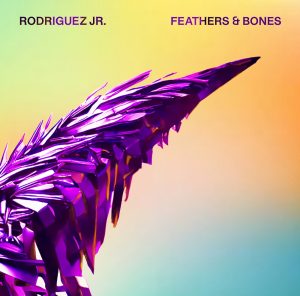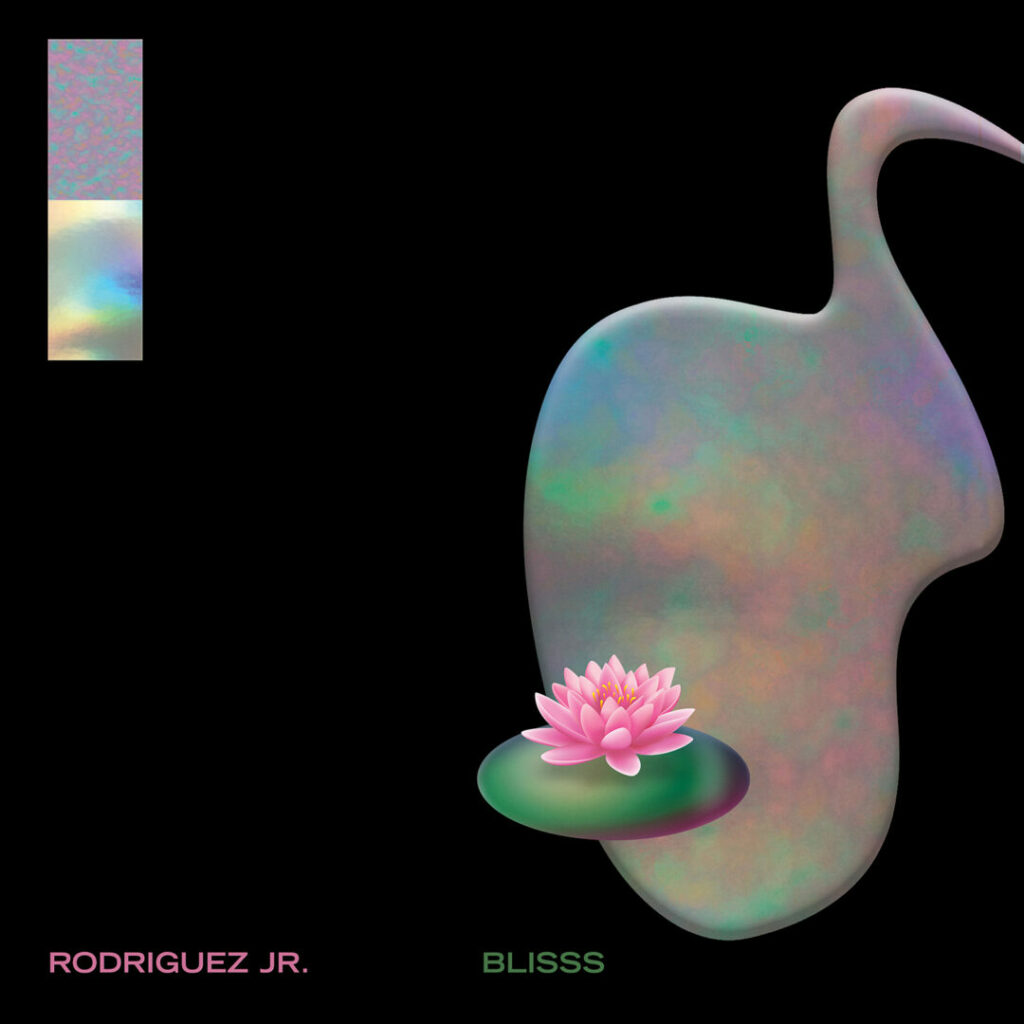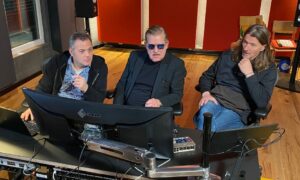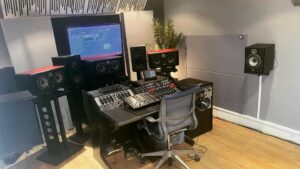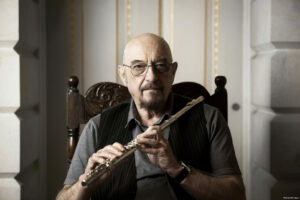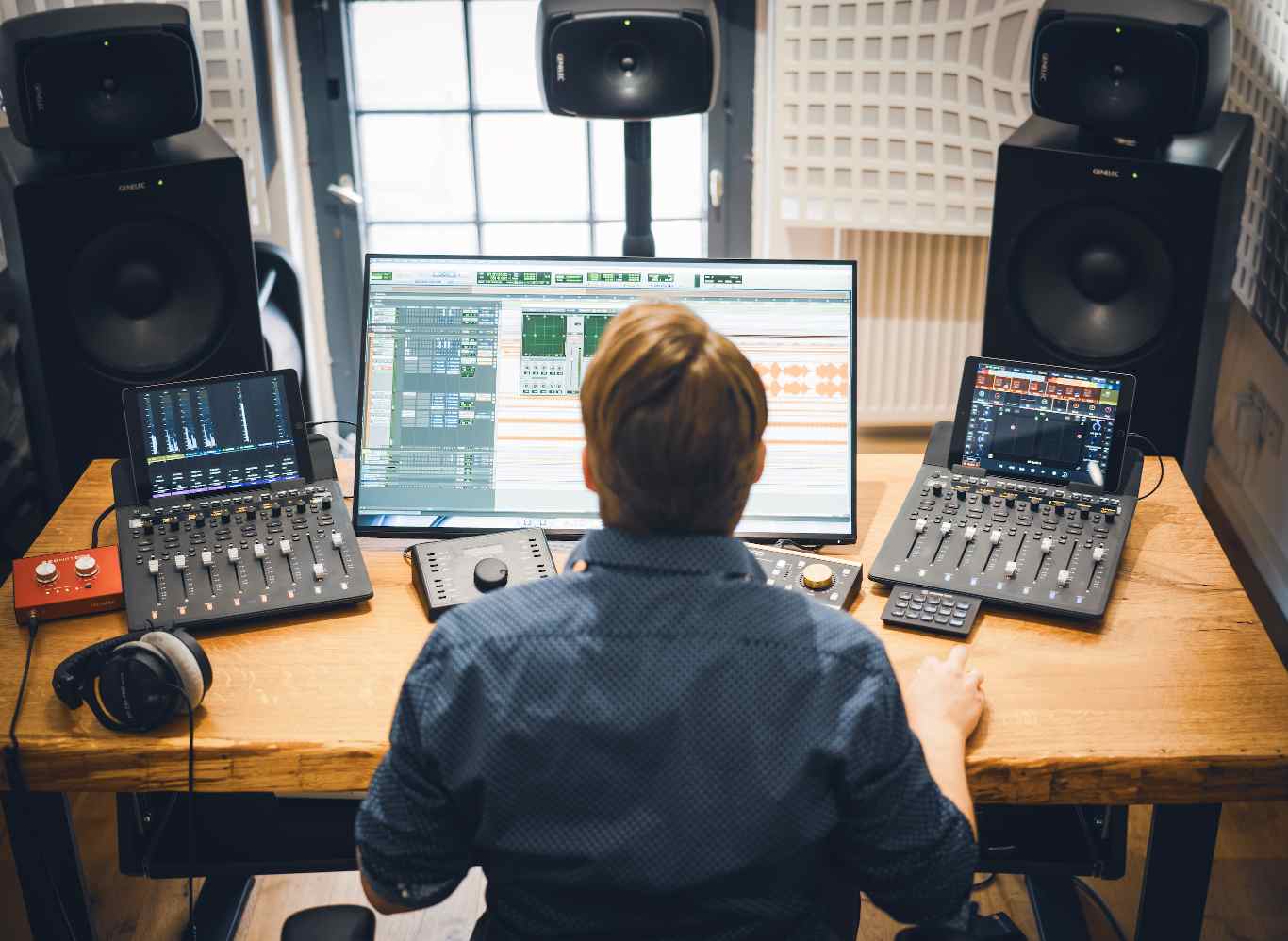
Music is in his DNA – Eric Horstmann lets us take a look behind the scenes of his studio and tells us about his beginnings and how he experienced the launch of immersive audio technologies such as Dolby Atmos. We spoke to him about how he helped to establish the format, about the finer points of mixing and asked him where he sees the future of the music industry. The interview was conducted by Christoph Diekmann.
Hello Eric and welcome to our series of interviews about immersive mixing studios and creative engineers.
Thank you very much for inviting me!
You’re very welcome.
Why don’t you tell us briefly how you got started as a mixing engineer? You studied sound engineering, but didn’t go straight into it, right?
That’s true. I graduated from SAE (School of Audio Engineering) over 20 years ago and then it’s always such a gamble afterwards – do you end up in the industry or not? Unfortunately, the degree is not necessarily super highly regarded, these days. But you struggle your way through. I first started doing various internships in classical music production environments. I was in the Trixx Studio in Kreuzberg and recorded there with people like The Who, Manfred Mann and Udo Lindenberg. There were always a few funny people who came by, especially when they were on tour in Berlin.
But then I found my way into film post-production relatively quickly and actually worked in film post-production for over ten years. As a small technician in audio transfer – back then you still worked a lot with picture tapes, with perforation and with film rolls and all that stuff – none of that exists today. And then I progressed further and further, going through various stations, so that in 2012 I was able to build the first German Dolby Atmos studio for mixed cinema and post-production at Rotor Film in Babelsberg.
At that time, the format was still in beta and we experienced virtually all the teething troubles of Atmos at first hand. That gave us a lot of gray hairs, but I’ve been associated with this format ever since. And of course we also mixed the first German movies in Dolby Atmos. And, if I am correctly informed, we have created the first European, native Dolby Atmos mix for a movie. At that time, there were often only 5.1. or 7.1. versions. At most, we went back a bit when mixing, took out a few elements and then used them as objects, but we actually mixed the first German, European film natively in Dolby Atmos – from scratch. And that was very nerve-wracking and time-consuming, but I think it was worth it – at least the experience gained.
Which movie was that?
It was called “Lost Place”. It was actually a small movie set in the Palatinate Forest. It’s about an invisible threat in the sense of sound waves – and the theme of an invisible threat can of course be told in a really great way in terms of sound. But let’s put it this way, when I hear the mix today, I think to myself: “Hm, I would do a few things differently today.” We rotated the entire orchestra around the actor and such gimmicks – technically everything is possible. Whether it really makes sense creatively is perhaps looked at differently today. But we were able to learn a lot and experimented a lot with the format and I’ve been hooked ever since.
A few years later, Dolby Atmos also entered the music sector. You launched with Immersive Lab in 2019 and were therefore also quite early on involved with the topic in Berlin. How did this come about?
Basically, it was my passion. The reason you end up in this industry at some point is often because you have some kind of connection to music. Either you are an active musician, an active listener or a person interested in sound and music in some way. I originally wanted to study jazz and popular music for guitar, but I realized that I’m actually far too bad for that. And then I thought to myself: “Well, I’ll just go behind the scenes”. That was my reason for coming to this scene in the first place.
In other words, music has always been part of my DNA and has always been very important to me.
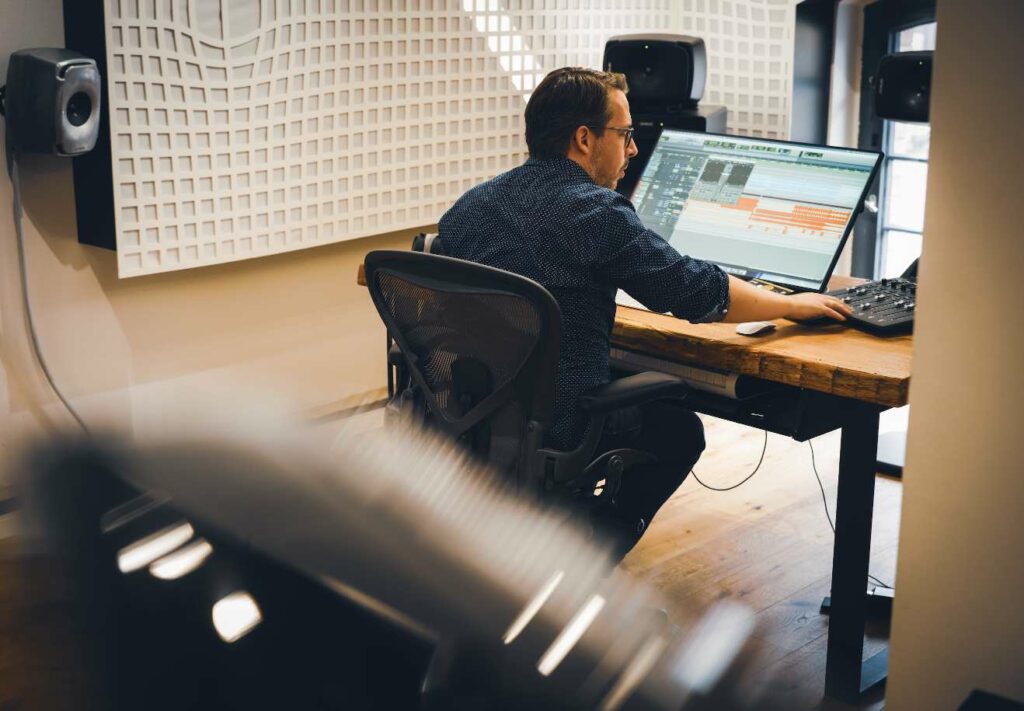
I’ve always played in bands, I’ve had a thousand music projects and I’ve also released a lot of music myself. And then Dolby Atmos came along and I thought to myself: “Great, now I can combine my technical knowledge from the cinema sector with my passion for music and tell people what it is and what great things you can do with it.”
Of course, nobody was interested in that at the time, to be fair. Back then, it was just a lot of talking and a lot of door-to-door canvassing and holding up the flag for an art form that nobody knew at the time that they might need or be interested in at some point. I was at the start relatively early on, because as I said – I just wanted to do it, I just wanted to do it. I then invested a lot of time, money and energy in making it appealing to people, playing it, making test mixes, inviting people to the studio and so on. The whole classic career path, as for many who started to deal with the topic during this period. But I was one of the earlier ones, that’s true, with a few colleagues from Munich.
In your opinion, what are the advantages of immersive audio over stereo?
I would like to clear up a prejudice first. Many people say that immersive audio will replace stereo – I don’t believe that. It will be a nice second version alongside stereo – and it already is. It is important that there is a parallel premium segment, alongside classic stereophony, yes. But I can’t imagine the Tagesschau in Atmos. Object-based perhaps, but not really immersive.
The biggest advantage is simple: the music no longer just plays in front of you, but you are right in the middle of it. Depending on the quality of the mix, you may be able to place the listener in the middle of your piece of music. And the bottom line is this: What do the artists want, what does the producer want? But actually – what does the musician want? At the end of the day, he wants to convey emotions. You can use emotions to get people to listen to your music, maybe even buy it, maybe even go to a concert. And I think immersive audio, although very technical, is a very emotional sound format. Emotional in the sense that you let the listener into your inner self. Making music always means turning a piece of your innermost self outwards, which can be very intimate. And we have the opportunity to deal with it in a very intimate way, both acoustically and technically.
And there’s another thing I think is important: immersive audio helps people to start listening to music consciously again. So those times when you bought a record, put it on and sat down in your armchair were over for a while, they’re coming back now. With immersive audio, you also have the opportunity to encourage people to listen again: Listen. Sit down, take five minutes and listen to the track, or take an hour and listen to the whole album. You’re no longer just being blasted by a horn to the right and left when you’re somewhere, as long as it’s blaring something – but it actually helps to consciously embrace this art form again and to listen more closely to what the artist is actually trying to tell us with it.
And how did you equip your studio to achieve this?
Of course, I follow the technical specifications that Dolby has also published. This means that I have a 7.1.4. Speaker system. My room isn’t crazy big now, I have 21 square meters, but it sounds very, very good, it’s acoustically well set up. And for me it’s important to say that the ceiling speakers in particular are in the Dolby specification – but not 100 percent, maybe 80 percent. They’re actually a bit too far out, so I can actually cover a bit of AURO-3D as well. Starting from the fixed positioning of a loudspeaker in the room, there is a way of arranging the two formats in such a way that you can use both formats in the best possible way as a compromise. And that’s what I’ve done here. There were also small structural obstacles, I have a sloping ceiling here because I’m in the attic of former stables, which means I couldn’t change the spatial situation anyway, and then it just so happened that we did it this way here.
The most important thing is that you have a 7.1.4. speaker system, in my case, I have one from Genelec. And otherwise there are various tools for peripherals that you can use – I work on a Protools basis. There are others who work with Nuendo or Logic Pro or other options. The nice thing is that in the end, no one asks which tools you worked with, everyone just judges the result and that’s actually my favorite thing. The way we get there varies from colleague to colleague, but we all try to achieve the same goal somehow.
The products you have mixed so far come from many different genres. Pop and electro, but also rap works are increasingly represented in your work. Is there any favorite style for you where you say: “This is my music, this is where I feel at home!”?
Yes, there is. I’m actually a very musically open person, so I listen to everything, I used to play in a hard rock-numetal band, but I have an electronic music project and also work very closely with house labels. My personal musical spectrum is very broad, I can listen to anything and I think everything is cool in some way. Speaking for my work now, well, at some point you develop your own signature, even as a mixer. The colleagues who work a lot in jazz and classical music have relatively unique practices and techniques that they use, where at some point you assume that this work must come from that direction – and that’s how it is.
I am very, very closely associated with electronic music. Of course, this is also due to the fact that Berlin is a good place for electronic music. It’s a bit of an epicenter here, and a big hub for electronic music. And, as you know, there’s also my connection to Mobilee Records – it’s also of a friendly nature, we’ve been friends for a very long time. There are some really great products coming out of the label, which in my opinion are ideally suited to the format. And that’s why we’ve decided that everything that happens at Mobilee now happens in Atmos.

Is the mixing approach different for you depending on the genre? Or do you always approach your work in the same way?
Let’s put it this way – my technical organization, my Pro Tools templates are identical, no matter what genre, but of course there are differences in how I deal with them. The best example is always vocals: in electronic music, especially when it’s house or techno, vocals don’t play as important a role as they do in rap, for example. In rap, the focus is on the vocals. And then of course you have other options for how you deal with vocals. In electronic music you think to yourself: “Yeah, there’ll be some sample, something will squeak by” and it’s not so important from where, you can deal with it a bit more freely. With rap, on the other hand, it is of course important that there is an anchor somewhere.
I’m relatively open-minded and I actually look at each song on its own merits.
I listen to what exciting elements there are in the song, is there a nice line, what story does the song actually want to tell me, what is the dramaturgy? Because in the end, a piece of music is like a piece of film, it also follows a dramaturgy, has arcs of tension, and I try to read them out a bit for myself. It may be that I interpret them differently than they were meant, but then that’s a bit of my color that I bring into it. That’s why every song is first judged for what it is and then I look at what I think fits best.
Did you always use stereo as a reference at the beginning?
No, not always. I actually have some projects where there is no stereo mix at all. We first mix in Atmos and then turn it into a downmix. This is then slightly modified to create the stereo version. But unfortunately it’s still too rare – I wish it happened more often.
What does the base material for your mixture look like? Are the artists and producers open to giving you as many tracks as possible? We have also heard of cases where a few stems have been sent and then Atmos is supposed to be conjured up from them. What is it like with your customers or partners?
In the meantime, I’ve built up a relatively good relationship with people over the years. That means they already understand what I need and what I don’t need and what I would like, so that we can simply create a good product together.
And there are some customers who send me everything I need, and they know it too by now. If it’s a new customer, I usually send a PDF document in advance and ask them to follow it as closely as possible. It contains everything I would like to have so that I can ensure the smoothest possible Atmos mix.
But things are actually getting better and better. All the stereo producers are starting to understand – not 100 percent, but they’re getting an idea of what Atmos is and what it takes. Some of my customers have thrown their stereo workflow overboard in order to simply lay out the files from the outset in such a way that they also fit for an Atmos mix later on. That’s a luxury, of course.
Let’s put it this way – that doesn’t happen with the majors. With the indies, you have the chance. And that’s why I’m a big fan of working with indie labels. The communication channels are shorter, the motivation is greater and that’s why you can actually get a colleague into the studio more often to listen and maybe even mix together.
As representatives of the physical Blu-ray format, we have the nice situation that a Blu-ray release often includes visual material or multimedia content. You came into the field from film – how do you see the visualization of music? Do you see a lot of movement in this direction?
Basically, I do believe that. Now, I can’t speak for the broad pop masses. I just know that in my electronic music, visuals always go hand in hand with the music. The artists often have video walls behind them live and there are very special visuals that are timed to the music, which are also linked to each other via timecode.
Dubfire or Len Faki, for example. They may be in the hard techno area, but they play on stages in front of 15,000-20,000 people and of course have huge video walls around them, where very specific content has already been pre-produced for them. They have their own people who take care of the visuals and of course that’s fun when you go to Blu-ray, because then you have this uniqueness of the music coupled with the visuals that you can otherwise only experience when you go to a concert or a club.
Of course, it’s an exciting story when you combine these things. A conventional, normal music video is nice, it works, but you can also find it on YouTube if you need it. But these visuals are a real added value in my opinion, because you don’t see them if you’re not at the concert.
And that’s also a bit of my vision – and I always try to tell people that when the subject of Blu-ray comes up – and it comes up more and more often, I have to say.
If you could highlight one of the blends you have created, which one would it be?
There are a few that I’m quite proud of and I enjoy listening to them – and of course I’m pleased that they’ve been well received so far.
Moderat is one example. I mixed the last Moderat album “More D4TA”. It was relatively restrained, I would say, when it came to utilizing the immersive space. But I think the band and I have managed together to get it just right for them. You get a huge, technical playground and can go completely crazy if you want, but it also has to be appropriate for the song – it has to serve the artist and fit into the concept.
I think Moderat’s record turned out very well. The two Rodriguez Jr. albums, “Bliss” and “Feathers & Bones”, are also very nice, and are also available on Blu-ray.
But in my opinion this shows again that the best mixes are also the ones where you are somehow in close contact with the artist. And not just as a service provider at the end of an Excel list, but really being in contact with the artists, talking about creativity, maybe just hanging out with them for three hours and having a coffee, just to get to know them. And I’ve known Rodriguez Jr. for almost four years now, we’re very close friends, so we’re in constant contact. And I have the impression that you notice that in his composition, in the things he gives me and in what I then create together with him.
And it was the same with Moderat. We also did a lot of preparatory work, the band and I, just chatting and thinking: How do we do it? What do we want? What does the band want? What can I contribute? And these are the products that I think will be very beautiful, because there’s some kind of heart to them.
If you really see it as a creative process, and not simply as a mixing performance that happens at some point because it has to happen. If you simply say to yourself: This is simply this playground, then it is ultimately a new element in the whole sound experience of the composition.
And if we can get that established and fully exploited, I think we’re on the right track, because that simply leads to a completely different listening experience.
That’s why it’s so important to me – and to many other colleagues – to have contact with the artist.
Perhaps also to do a listening session without necessarily listening to your own products, but simply to say: “Here, let me show you something, what do you think?” Simply to check how far I can go. I’ve proven that I can operate the system and now the question is, how do I get the art into it?
I am always a great friend of exchange. And I now have a few projects where I don’t know the artists yet. We actually met and found each other via Instagram and said we’d meet up for a listening session. It goes into the neoclassical area, mixed with electronics, that’s really great stuff – who knows, maybe we’ll talk about it again. But we’re so early in the process that nothing has been produced yet, not even stereo. Very fresh. And who knows, maybe we can do something about it from the outset.
Are there any other upcoming projects that you can already talk about?
It’s actually a bit quiet at the moment, I have to say. There’s nothing big up our sleeve. Thomas Lemmer’s new album will be released at the end of February. It’s a very nice project that goes in the direction of downtempo ambient electronica. This is a joint project with Oine, a producer from Spain.
What I can already talk about, at least in part, is that there will be a crossover project with Deutsche Grammophon. It’s called Fragments II. The idea was to have classical pieces by the French composer Lili Boulanger reinterpreted by electronic music producers and artists. One of the artists who was approached was Rodriguez Jr. And that’s how we came to be in charge of the entire project, at least as far as the atmospheric mix is concerned. And there are lots of different artists involved: Rodriguez Jr, Niklas Paschburg, il:lo, JOPLYN, Anja Schneider – lots of well-known names from the electronic music scene. And we’re releasing one single at a time, and the album will be complete around September or October.
It was a wonderful project and I’m really looking forward to when it sees the light of day. A lot of work went into it, but it turned out really great.
Then thank you for your time.

You’re welcome!
Anyone who would like to contact me can do so via the channels:
www.instagram.com/immersive_laboratories
I am happy about every contact – everything for art.

